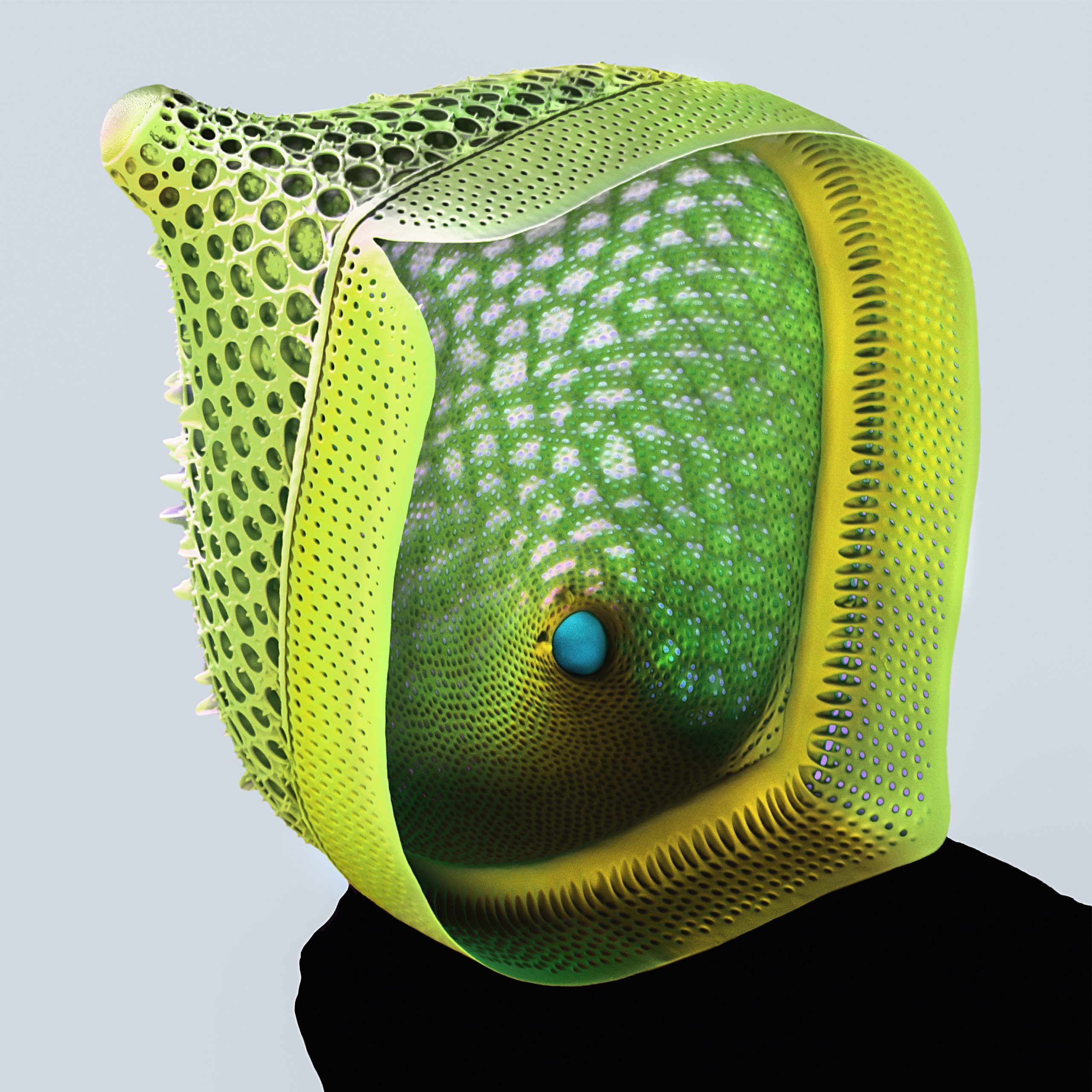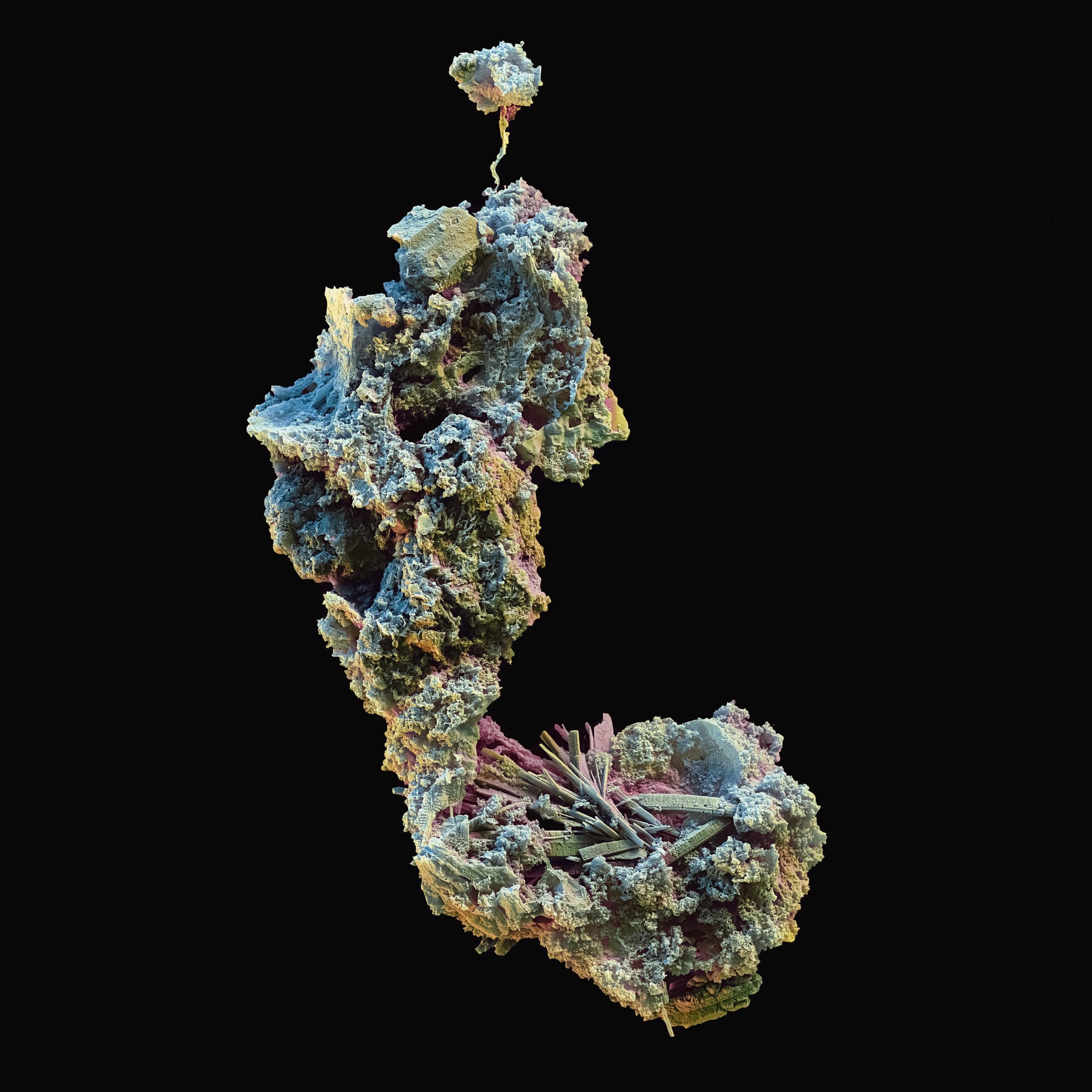Andreas Greiner & Stefan Diller
Andreas Greiner lives and works in Berlin. After studying medicine, anatomy and sculpture he focuses on time-based and sculptural art works. His creative aim is to push the boundaries of classical parameters in sculpture. The content of his work focuses on the anthropogenic influence on nature’s evolution and form. He is part of the artist collectives A / A and Das Numen.
His first glance through his own scanning electron microscope will be unforgettable for him because it opened up a door to an unknown universe of yet unseen aesthetic structures, in their view awesome to behold.
With the naked eye structures in the plant kingdom and the animal kingdom leave no real impression on us. But what universe lies in dimensions below 100 micrometers? With optical microscopes we are able to see structures down to some hundred nanometers, but without much field of depth. Scanning electron microscopy brings more than a thousand-fold field of depth, with some physical effects to enhance small parts of the specimen.
Stefan Diller works together with Andreas Greiner.
Desert Trip / Wüstenwanderung

Salin
Scanning electron microscope image of a sediment sample from a drill core from the bottom of Lake Yoa in Northern Chad from 16.115 m depth (10,298 years old).
The cores these sediment samples were taken from are used as evidence of the occurrence of a fertile period in the Sahara. Like the ice cores recovered in Greenland, which are used to determine the carbon dioxide content of the air at different ages of the Earth, they are important scientific discoveries that contribute to the development of current climate models and the controversies that accompany them.
Rasterelektronenmikroskopaufnahme einer Sediments-probe eines Bohrkerns aus dem Grund des Yoa-Sees im Tschad aus 16,115 m Tiefe (10’298 Jahre alt).
Die Bohrkerne, aus denen diese Sedimentproben stammen, und die als Beweise für die Existenz dieses fruchtbaren Zeitabschnitts der Sahara angeführt werden, sind, wie die in Grönland geborgenen Eisbohrkerne, mit denen der Kohlenstoffdioxydgehalt der Luft verschiedener Erdzeitalter bestimmt wird, wichtige wissenschaftliche Funde, die zur Entwicklung derzeitiger Klimamodelle und der sie begleitenden Kontroversen beitragen.

The Green Desert / Die Grüne Wüste
Scanning electron microscope image of a sediment sample from a drill core from the bottom of Lake Yoa in Northern Chad from 13.095 m depth (7,723 years old).
The depicted micro landscape of desert dust, grains of sand and fossil micro deposits show a stunning similarity between microscopic and macroscopic structures. Amidst it there’s the sudden appearance of life: the outer skeletons of diatoms were deposited at a time when Lake Yoa was a freshwater source and the surrounding Sahara was transformed into a green savannah landscape.
Rasterelektronenmikroskopaufnahme einer Sediments-probe eines Bohrkerns aus dem Grund des Yoa-Sees im Tschad aus 13,095 m Tiefe ( 7723 Jahre alt).
Die dargestellte Mikrolandschaft aus Wüstenstaub, Sandkörnern und fossilen Mikroablagerungen weist zwischen mikroskopischen und makroskopischen Strukturen Ähnlichkeiten zu der lebensfeindlichen Wüste Sahara auf. Trotzdem tut sich in deren Mitte überraschend Leben auf: die Aussenskelette von Kieselalgen lagerten sich in einer Zeit ab, als der Yoa-See Süsswasser führte und die umliegende Sahara zu einer grünen Savannenlandschaft wandelte.

Hypersalin
Scanning electron microscope image of a sediment sample from a drill core from the bottom of Lake Yoa in Northern Chad from 0.335 m depth (168 years old).
The importance of the drill cores is based on the fact that the sedimentary layers of Lake Yoa form a complete “climate archive” of the African continent for the last 10,000 years and longer. Finest layers allow a differentiation of up to four climate states per year. They represent the reference sample for all climate models of the African continent. Their evaluation is still subject to various scientific projects.
Rasterelektronenmikroskopaufnahme einer Sediment-probe eines Bohrkerns aus dem Grund des Yoa-Sees im Tschad aus 0,335 m Tiefe (168 Jahre alt).
Die Wichtigkeit der Bohrkerne beruht auf der Tatsache, daß die Sedimentschichten des Yoa-Sees ein lückenloses «Klima-Archiv» des afrikanischen Kontinents der letzten mehr als 10’000 Jahre bilden. Feinste Schichten erlauben eine Unterscheidung von bis zu vier Zuständen pro Jahr. Sie stellen sozusagen die Referenzprobe für alle den afrikanischen Kontinent betreffenden Klima-modellierungen dar. Ihre Auswertung ist immer noch Gegenstand verschiedener wissenschaftlicher Projekte.
